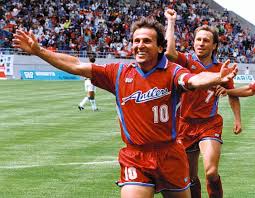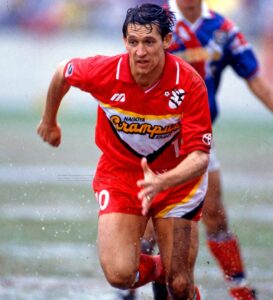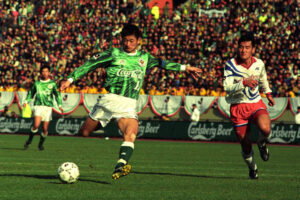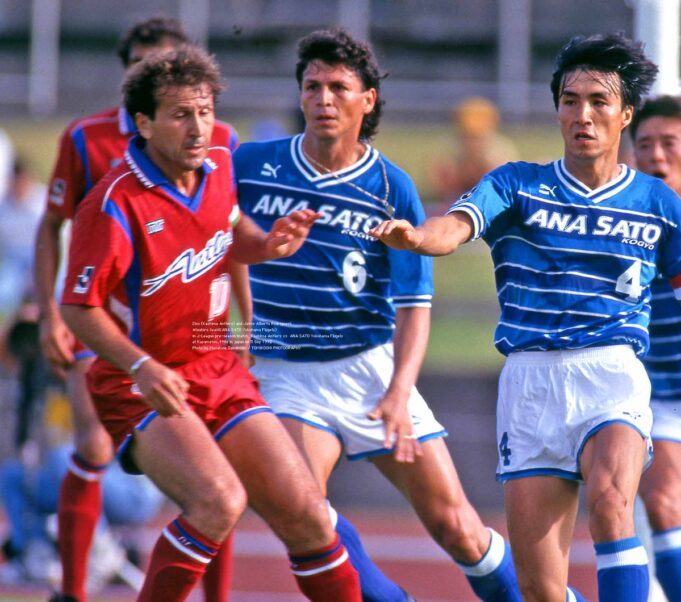Retirement league? Have you ever heard of this contemporary soccer term? It may sound unfair but many fans around the world have dubbed big money non-European leagues as retirement places for high-profile ”ageing” players. Soccer stars in their 30s quite often accept lucrative offers from Saudi Arabia, UAE, Qatar, China, and of course MLS for their remaining playing years. Would you like some examples? There are way too many. Xavi, Batistuta, Romario, Beckham, Henry, Pirlo, Hugo Sanchez, Ibrahimovic, Bebeto, Tevez just to name a few. Three decades ago Japan was one of the leading places attracting those ”retirees” (it still does). But the J League was much more than a retirement league.
The last year of the old JSL
The 1991-92 season was the last one of the old Japan Soccer League which was considered rather mediocre among other Asian leagues at the time. Yomiuri SC won easily the title with Nissan Motors Yokohama trailing by 8 points. And most of the Japanese clubs did include their corporate brand in their names back then: Yamaha Iwata, Mazda Hiroshima, Toshiba Kawasaki, Honda FC, Mitsubishi Motors FC, Toyota Motors Yokohama, Hitathi FC etc. All very well known Japanese companies. The greatest star of that league was Kazuyoshi Miura, the King of Japanese soccer who is still playing in the top division at the age of 54!
Miura alongside Brazilians Toniho and Ruy Ramos helped Yomiuri clinch the title in that season. Ramos was playing for Yomiuri since 1977, while Toniho had finished topscorer in 1992. The Tokyo club was probably the wealthiest of that league with an ambitious ownership who wanted to create a soccer empire equivalent to the club’s baseball section, the Yomiuri Giants. The Giants were a star-studded powerhouse in Japanese baseball with many fans across the country. And the soccer section was following the same path of success with 5 league wins until 1992, equaling Mazda’s record.
The latter had two foreign defenders in their squad: Czechoslovakian Julius Bielik and Dan Calichman who later played for the USA national team. Uruguayan midfielder Pedro Pedrucci was playing for Toshiba, Brazilian Carlos Renato for Nissan Yokohama, Putinatti Jorginho for Toyota Nagoya and Slovenian Primoz Gilha for ANA Yokohama. But none of these names were anywhere close to the magnitude of the foreign player who was playing in the second division. And this player was the great Zico!

Zico’s surprise transfer
The highest goal scoring midfielder in the history of soccer shocked the world in 1991 when he decided to return to the game at the age of 38, quitting his political assignment as the Minister of Sports in Brazil and signing for a second division club from Japan! Soccer and Japan? No one really had heard much about it until Zico moved over to the land of the rising sun. Zico signed a one-year contract with Sumitomo Metals from Kashima with an aim to help the team secure a place in the first division. And he did it emphatically with 21 goals in 22 games earning also the topscorer award. Sumitomo did not manage to win the league title which was grabbed by Fujita Tokyo led by Brazilian wizard Pita. However the second place was enough to give Sumitomo the ticket to the newly formed JSL.
1993 J League: the new professional league
The Japanese Federation had already announced the creation of the new professional league in February 1991, leaving the semi-professional status behind. Shimizu Pulse was the only new club formed to join the new 10-team league. The rest were part of last season’s top division. However, their names would be changed, getting rid of the corporate brands. Sumitomo Kashima would become Kashima Antlers, Nissan Yokohama would change its name to Yokohama Marinos, Toyota Nagoya to Nagoya Grampus Eight etc. But that development would be followed up by some soccer stars of world fame joining the J League.
Gary Lineker, the English forward who had spent 10 years terrorizing defenses in England and Spain, signed for Nagoya G8 after the Japanese club paid 1.5 million sterling to Tottenham! The biggest amount spent for a transfer in the Japanese soccer at the time. And it served as a signal of intent to the rest of the world that the Japanese soccer had finally arrived for good.
Lineker would be Japanese soccer’s highest paid player and the new poster boy alongside Zico and Miura. Soccer in the country had just become more attractive to larger crowds. Lineker was not the only household name that joined the J League in May of 1993. 19year-old and future superstar Marcio Amoroso signed for Verdy Kawasaki (merged with Yomiuri) as his fellow Brazilian Farias Bismarck. US player Dan Calichman remained in Japan signing for Sanfrecce Hiroshima. The latter had already completed the transfer of Czech Pavel Cerny from powerful Sparta Prague. Edu Manga had left Corinthians for Shimizu Pulse, and Yokohama Marinos brought in three great Argentinians: River Plate’s legend Ramon Diaz, David Bisconti and Gustavo Zapata. And, Marinos’ crosstown rivals, Yokohama Flugels convinced Edu Marangon to leave Palmeiras for them.
JEF United’s top signing was similarly audacious to the Nagoya’s one that involved Lineker. The club from Ichihara lured a World Cup winner: German Pierre Littbarski! The 33 year-old defender moved to Japan alongside his Koln teammate Frank Ordenewitz. Bulgarian Kiril Metkov was a low profile transfer for Gamba Osaka, while Urawa Red Diamonds signed another German duo. It was Eindracht Frankfurt’s striker Uwe Rahn and Borussia Dortmund’s 29-year old midfielder Michael Rummenigge who joined him afterwards.

The championship started on 15 May 1993 and finished on 16 January 1994 with the grand final between Kashima Antlers and Yomiuri Verdy Kawasaki. Kazu Miura was the most dominating player of the two-legged final leading his team to its 6th title. Verdy also won the Cup against Shimizu Pulse in 1993 achieving the double. On the other hand, Zico inspired newly promoted Kashima to finish runners-up! The Brazilian legend did not win silverware in the J League’s inaugural season, but the second place was a success. And more glory for his team would follow in the next seasons.
Lineker did not shine, but instead Argentine forward Ramon Diaz led the goalscorers’ table with 28 goals. And the MVP of the year? Who else? Kazu Miura, once again the fans’ favourite.

Attendances and the stars of the mid 1990s
The second leg of the grand final attracted a crowd of 59,715 to the Tokyo National Stadium. Nothing similar had happened before in the Japanese soccer. The champions from Tokyo had an average attendance of 25,235 while the league averaged 17,976 fans. J League sold over 3.2 million tickets over the course of the season! Japanese soccer had just put itself on the map. More world-famed legends would follow in the mid 1990s: Dunga for Jubilo Iwata, Dragan Stojkovic for Nagoya, Jorginho and Leonardo for Kashima, Cesar Sampaio and Zinho for Flugels, Stoichkov for Kashiwa Reysol, Ronaldao for Shimizu, Wynton Rufer for JEF, Julio Baldivieso for Marinos. All of them were active internationals (even captains) while they were playing in the J League! And there were more foreign stars who had already retired from the international level when they moved to Japan: French Basile Boli, Brazilian Careca, Czech Ivan Hasek, Argentine Alberto Acosta, Italians Massaro and Schillaci, Spanish Txiki Begiristain, German Guido Buchwald, Dutch Peter Huistra and many others. And of course legendary coaches like Arsene Wenger who worked for Nagoya before taking over Arsenal.
Zico had paved the way and the others just followed making Japan the Land of the ”Rising Soccer”.







[…] Source link […]